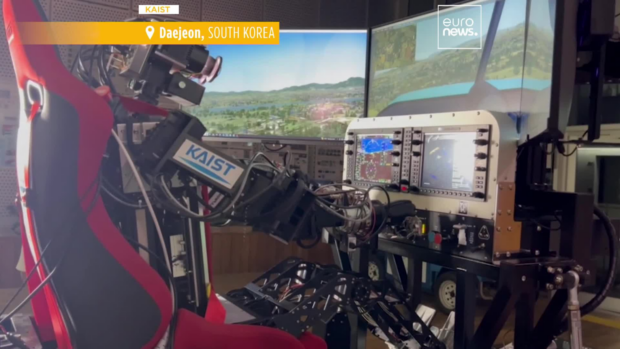Remember the iconic movie “Top Gun: Maverick” where the Air Force considered replacing Maverick with an artificial intelligence (AI) pilot? Well, South Korean scientists have brought us one step closer to that reality by unveiling a groundbreaking humanoid robot that can fly airplanes and understand complex manuals. This means that with just a few adjustments, the robot can operate various aircraft. It’s truly amazing how the real world is catching up with the futuristic depictions shown in movies and stories.
However, before we start booking flights operated by robot pilots, it’s important to note that the humanoid AI bot still requires further research and development to ensure its practical use and safety. Despite this, we can anticipate that the day when AI pilots are a common sight is drawing nearer.
Let’s delve deeper into South Korea’s humanoid AI pilot, known as Pibot. Pibot comes from the renowned Korea Advanced Institute of Science & Technology (KAIST) and was developed by Professors David Hyunchul Shim, Jaegul Choo, Kuk-Jin Yoon, and Min Jun Kim. According to David Shim, Pibot is a humanoid robot designed to operate an airplane just like a human pilot, manipulating all the controls in the cockpit. It’s designed to have limbs and fingers that can accurately operate flight instruments specifically designed for human pilots. Standing at 160 cm tall and weighing 65 kg, Pibot is optimized for sitting and working.
Professor Shim further explained that while the human form may not be the most efficient, they purposely designed Pibot as a humanoid because everything in aircraft cockpits is built for humans. It was found that the human-like form is somehow optimal, despite the possibility of having multiple arms and eyes.
Pibot is equipped with external cameras to monitor the aircraft’s status, while internal cameras assist in managing control panel switches. Additionally, the robot utilizes OpenAI’s large language model, ChatGPT, allowing it to “understand” and memorize flight manuals. This AI-powered feature enables Pibot to memorize emergency procedures and calculate safe routes based on real-time aircraft status. It can even communicate with air traffic controllers and other individuals in the cockpit using voice synthesis technology.
South Korea’s humanoid AI pilot, Pibot, is certainly impressive as it can not only pilot airplanes but also drive cars, operate tanks, and command ships. This seamless integration of AI into different vehicles and vessels showcases the extent of technological advancements in the field of aviation.
But let’s not forget other remarkable aviation projects. For instance, the United States Department of Defense and Lockheed Martin are collaborating to test an AI jet called VISTA X-62A. This jet incorporates multiple artificial intelligence systems that mimic various existing planes, such as the MQ-20 fighter drone and the F-16 fixed-wing fighter jet. This allows the US Air Force to test new AI systems without risking actual aircraft. However, it’s worth noting that while automated pilots may seem imminent, Lockheed Martin emphasizes the importance of keeping humans in control, enabling them to be safer, more effective, and better able to make well-informed decisions.
On a different note, NASA has been working on an experimental aviation project known as the X-59 aircraft, or the “Son of Concorde.” Unlike the AI pilots, this aircraft isn’t powered by artificial intelligence but by Quiet Supersonic Technology (Quesst). The X-59 airplane can reach supersonic speeds like the Concorde but produces softer sounds known as “sonic thumps” instead of the disruptive sonic booms associated with breaking the sound barrier. This breakthrough could make supersonic flights viable for civilian airports.
In conclusion, South Korean scientists have introduced us to a remarkable AI pilot, Pibot, capable of flying airplanes. With the integration of AI into aviation, we are witnessing the expansion of artificial intelligence into fields once considered purely science fiction. While Pibot is not yet ready for practical use, we can eagerly anticipate the day when commercial flights operated by AI pilots become a reality. The merging of AI and aviation signals just the beginning of a world where artificial intelligence revolutionizes numerous industries. Stay updated on the latest technological trends and tips at Inquirer Tech.
Denial of responsibility! VigourTimes is an automatic aggregator of Global media. In each content, the hyperlink to the primary source is specified. All trademarks belong to their rightful owners, and all materials to their authors. For any complaint, please reach us at – [email protected]. We will take necessary action within 24 hours.


